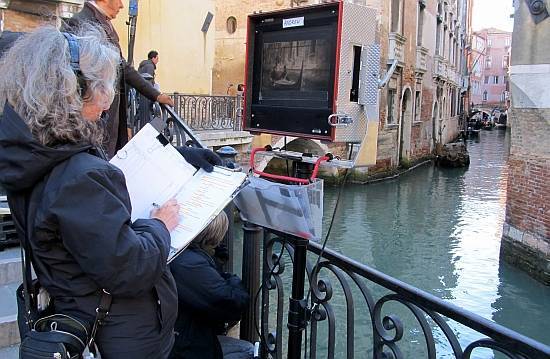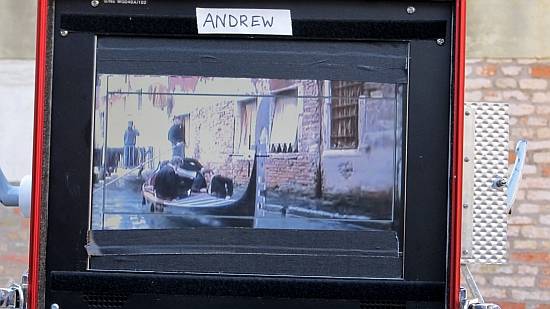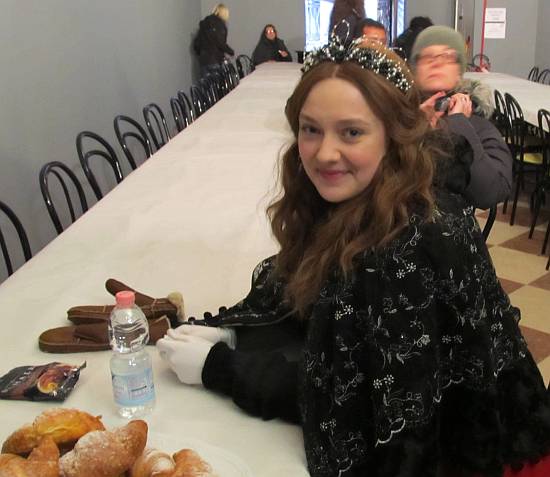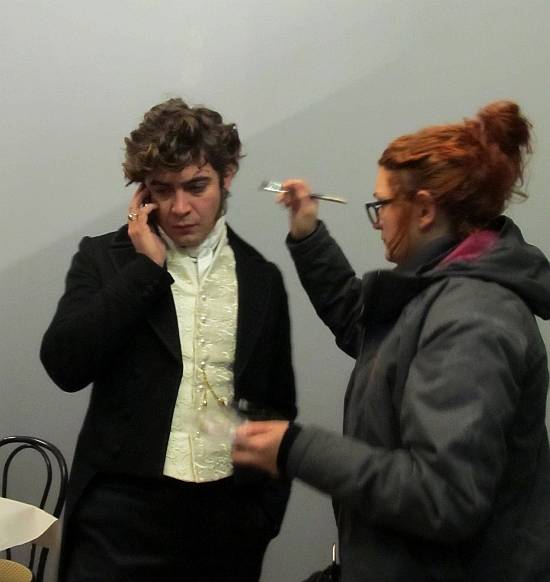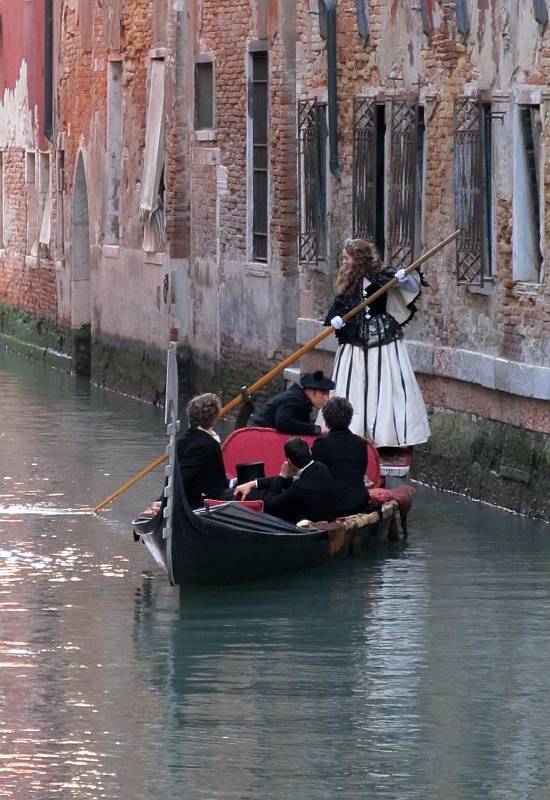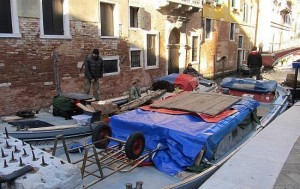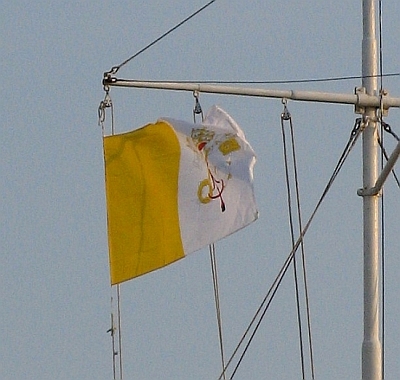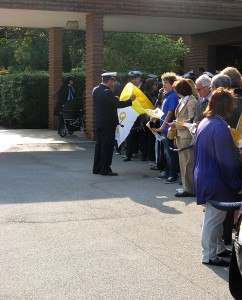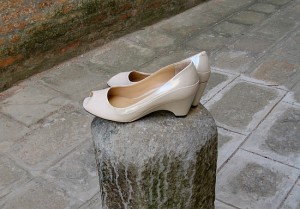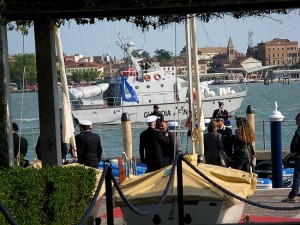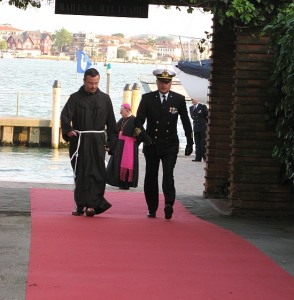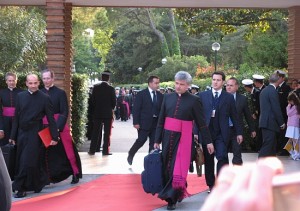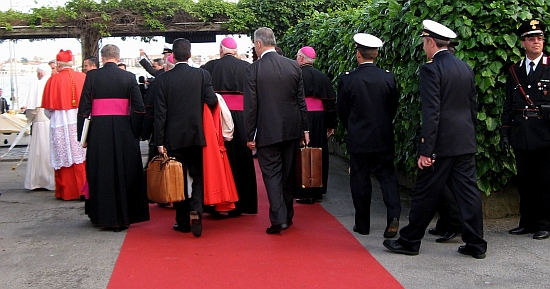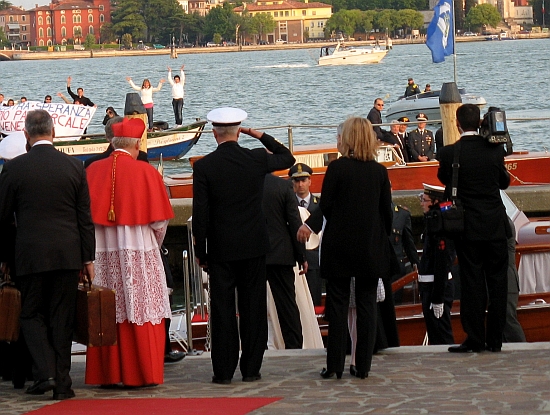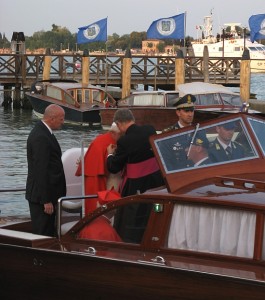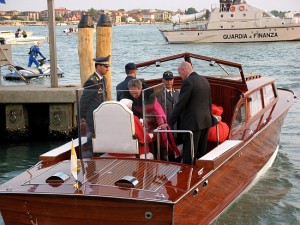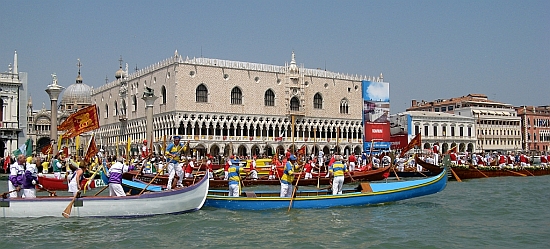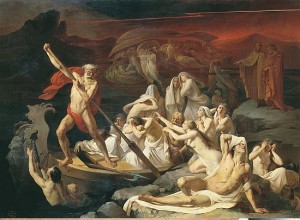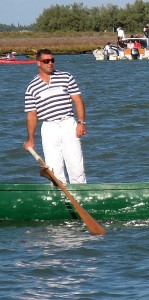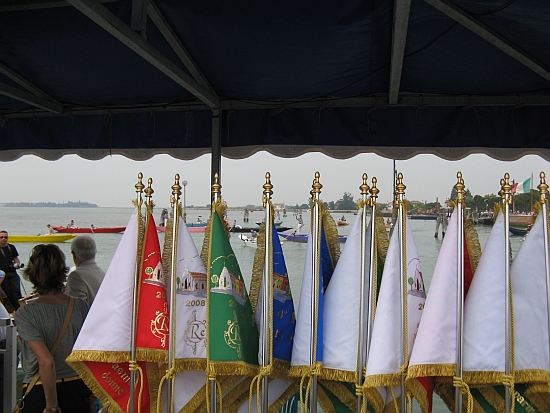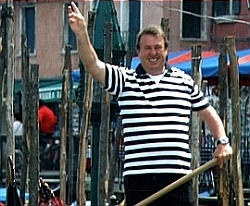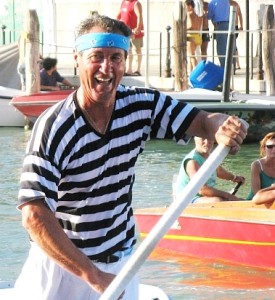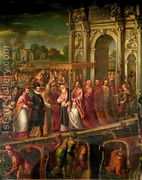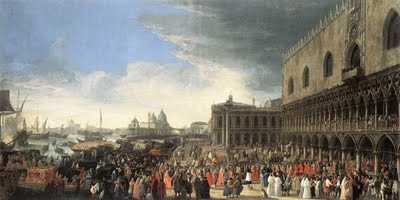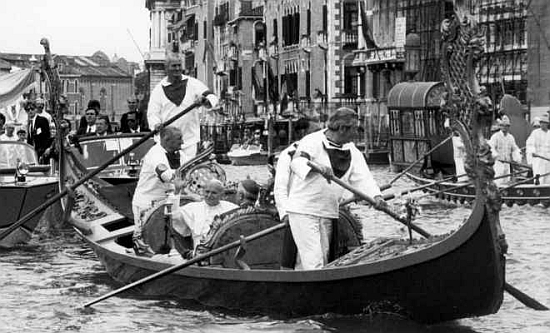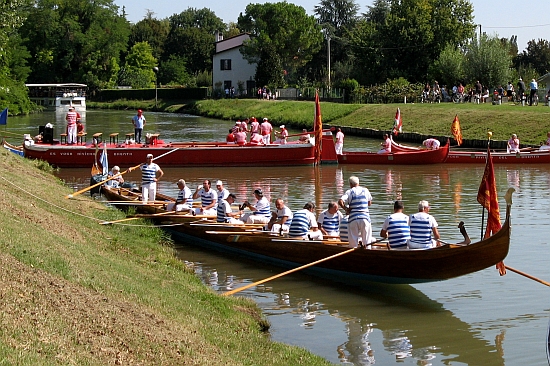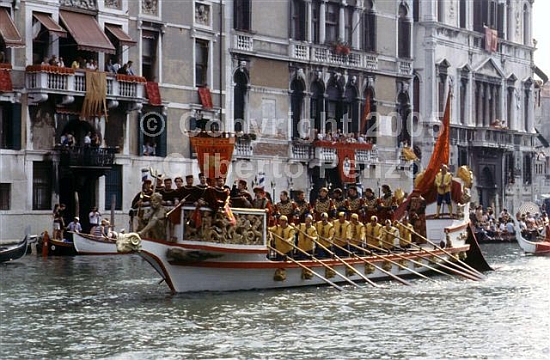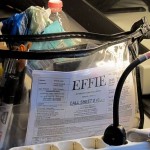
Every person who has come here in the last hundred years — and there have been a lot — has almost certainly said that the city looks like a stage set. This realization comes immediately after noticing there are canals instead of streets.
And if they haven’t said it, they’ve thought it.
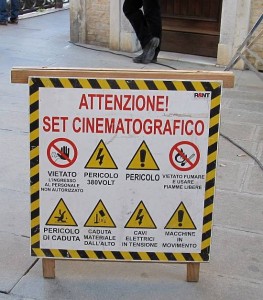
Venice makes the most of its stage-setness by offering itself as the location for at least a few segments of plenty of movies. Since I’ve been here I’ve come across bits underway of “The Italian Job,” “Casino Royale,” “The Merchant of Venice,” “Casanova,” “The Tourist,” “The Talented Mr. Ripley,” and a French feature named “Les Enfants du Siecle.” There may have been more. This is yet another way in which Venice resembles New York, including the fact that Venetians acknowledge all the fuss only in relation to how much inconvenience it causes them personally.
Evidently there are enough incentives to induce film companies to work here to offset the logistic challenges imposed by canals, tiny streets, lots of bridges, and skillions of people. I myself would hate to have to organize a film shoot — it’s hard enough organizing an ordinary day.
The latest movie to have cluttered the streets and canals with equipment and crew is called “Effie,” a biopic about the life of Effie Ruskin. It stars Dakota Fanning, a large number of non-Hollywood luminaries such as Emma Thompson and Derek Jacobi, and an Italian god in human form named Riccardo Scamarcio.
We were there as part of a group of members of Arzana‘, an association (of which Lino is a founding member) dedicated to the conservation of old Venetian boats of every sort. Whenever a film needs boats, the boats also need rowers, so anybody who applied and was chosen by the film company got a chance to participate in film-making for at least a day.
Lino and I went to the office, filled out the forms, got our portraits snapped, and waited to be called. He went three times, and I went twice.
So I urge you to see this film (it will be out in June 2012), because if nothing else interests you, you could peer in the darkness at the screen trying to discern a feminine figure in fusty nineteenth-century garb rowing a boat who could be me. I’m merely a human in human form, but I had a fantastic time as an extra.
Good thing I’m relegated to the background, though, because while the long skirts made me feel swell, the bonnet and slicked-back hair, all perfectly accurate, made me look like a Victorian cross between the Witch of Endor and Baba Yaga. If I’d been born in Effie’s time they’d have killed me in my cradle.
Lino didn’t come out much better. What with him and his cloth cap, high collar and muttonchop whiskers, and me with my shawl and apron and hat, we looked like a pair of Dickensian hobbits.

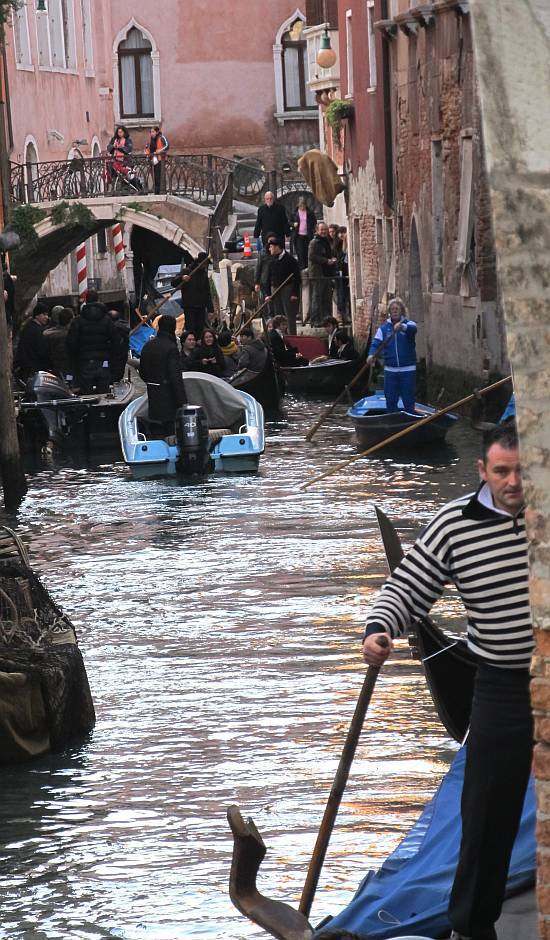
I had two days on duty. Most of the first day was spent watching the six hours or so of activity involved in shooting two minutes of film. We stood in the sun and ate loads of the free sandwiches the help was carrying around and watched an amazing amount of activity which seemed to happen without anyone telling anyone else what to do. Then we went inside and ate lunch.
At 3:00 Lino and I went to be dressed and titivated. When that was done, we climbed into a small mascareta and took up our positions on a stretch of small canal. By now it was 6:00 PM and getting dark, but lights were blazing everywhere.
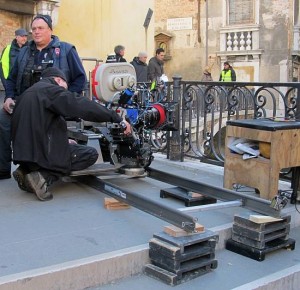
Our task, once the cameras started rolling, was to row very slowly along a snippet of canal only about 200 feet long (67 meters), which we accomplished in about a minute and a half. Also being rowed along the canal, in one or the other direction, was a battella and two gondolas, both replicas of the 17th-century version. One of the gondolas carried Effie and her husband, John Ruskin. By the look of things they were not happy. “There was,” as Dorothy Parker once wrote, “a silence with things going on in it.”
We repeated this slow row many times. I felt fine, except for my feet, which aren’t used to wearing shoes with heels (my costume included thin-soled mid-heel boots they’d given me to wear, even though nobody, not even me, ever saw my feet). The air wasn’t especially cold — thankfully, there was no wind — and God knows I wasn’t hungry.
At 10:00 PM it was quitting time. We changed our clothes in record time (the costume crew standing by to help), the makeup girl took off my hat and ripped out the 3,491 bobby pins which she had rammed into my skull to anchor my hairpiece, and we ran downstairs to the boats. Now we had to really row, to get them all back to the boathouse and tied up for the night.
Rowing at night is bewitching. There is almost no traffic, so you can actually hear the water murmuring under your boat; the distances and proportions are mysteriously transformed, and the combined effect is impossible to resist. There we were, sliding along the black glistening water flanked by prodigious palaces, virtually alone (I ignored the lone vaporetto), in a universe created by giants. And it belonged only to us. I’m not going to pretend these things don’t affect me, even after all this time. “My God,” I thought, “I’m rowing up the Grand Canal.”
Lino isn’t impervious to this allure, either; he said practically the same thing, and he’s been doing this all his life. Because there is no way to resist the sorcery of this city at night.
During the day, the city just lies there and dispenses, in a bored sort of way, a steady supply of small doses of beauty and splendor, just enough to make people want to take lots of pictures. But at night, she hurls caution and hauteur aside and utterly swamps you in a deluge of grandeur and seduction.
It was getting on toward midnight, but we didn’t want it ever to end.
Two days later, we were out in force on the Grand Canal doing a modified isn’t-the-city-busy sort of rowing around. It was sunny and warm, which is pleasant but sort of inane, and we got almost no food. You see how demanding I’m getting to be? And we didn’t row all that much, either.
We finished before sundown and the boats were back in their stalls before dark. No magic this time. But just as they say you can get so accustomed to chocolate that it just doesn’t do anything for you anymore, the same must be true of rowing at night. If we did it all the time, I suppose it would become boring.
I’m ready for the next film, whatever it might be. They can call me anytime — and I don’t care if they make me look like a mutant psychopathic canal-dredger.
